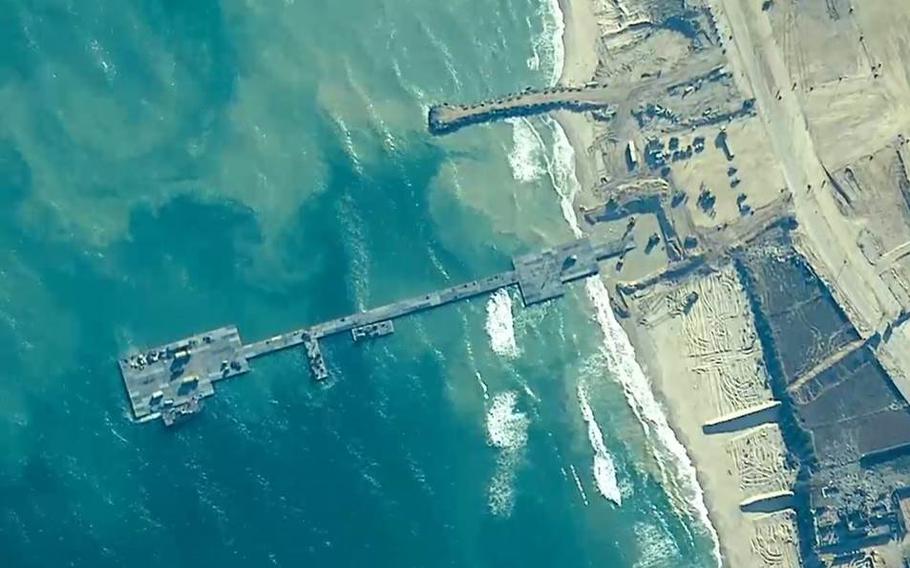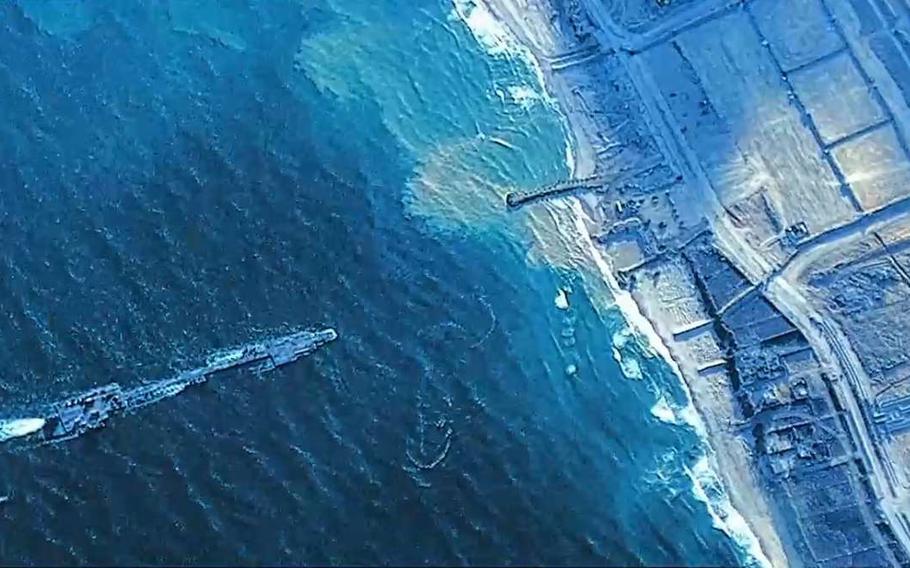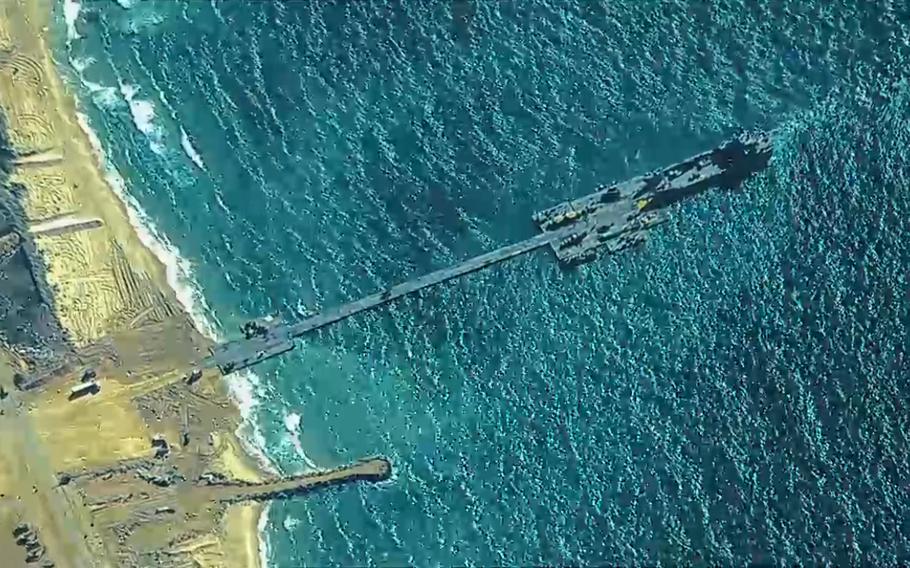
U.S. Army soldiers assigned to the 7th Transportation Brigade (Expeditionary), U.S. Navy sailors assigned to Amphibious Construction Battalion 1, and Israel Defense Forces install the Trident Pier on the Gaza coast, May 16, 2024. Humanitarian aid will start to move into the war-torn territory in the coming days, defense officials said. (U.S. Central Command)
WASHINGTON — The U.S. military has completed installing a floating, temporary pier off Gaza’s coast, and humanitarian aid will start to move into the war-torn territory in the coming days, defense officials said Thursday.
“This morning, just a few hours ago, the pier was successfully affixed to the beach in Gaza. And in the coming days, we will commence delivery of aid,” said Vice Adm. Brad Cooper, deputy commander of U.S. Central Command.
At 7:40 a.m. Gaza time, CENTCOM personnel anchored the pier to the beach. No U.S. troops entered Gaza, according to a CENTCOM statement posted on X.
The pier, known as Joint Logistics Over-the-Shore, or JLOTS, is meant to provide another way to deliver needed aid into Gaza. The World Health Organization has warned some 2.3 million Gaza inhabitants face extreme hunger that could become a full-blown famine by next month as Israel continues its war against Hamas militants, who launched a surprise assault in October from the enclave.
Sonali Korde, a U.S. Agency for International Development official, said the assistance is necessary because conditions on the ground have not improved, and a vital border crossing closed in the last few weeks. Israel on May 7 seized control of and closed the Rafah crossing, which aid organizations relied on.
“We need to just continue to work on getting more aid in through all routes. We’re at a point in time when this is all hands on deck,” Korde said. “We can’t spare any effort.”
President Joe Biden first announced the JLOTS operation on March 7 during his State of the Union speech. One day later, Air Force Maj. Gen. Pat Ryder, the top Pentagon spokesman, said the temporary pier would be operational within about 60 days.
A defense official on Wednesday said the U.S. military had begun moving parts of the pier toward Gaza from the Port of Ashdod, one of Israel’s three main cargo ports north of Gaza. The delivery of food and other aid could begin in the first 24 to 48 hours after installation, according to an NBC News report.

U.S. Army soldiers assigned to the 7th Transportation Brigade (Expeditionary), U.S. Navy sailors assigned to Amphibious Construction Battalion 1, and Israel Defense Forces install the Trident Pier on the Gaza coast, May 16, 2024. Humanitarian aid will start to move into the war-torn territory in the coming days, defense officials said. (U.S. Central Command)
The Pentagon announced last week that the U.S. military completed construction of the floating pier, but weather conditions made it unsafe to dock the pier to begin transporting more aid into the region.
Cooper said the future impact of weather on the pier is situational. The weather is expected to be good for the coming week or so, with the goal being to move as much humanitarian aid as possible and make assessments about the pier along the way.
“As we sit here now, we have about 500 tons of humanitarian assistance loaded on ships. That’s about 1 million pounds ready for the delivery in the coming days and … thousands in the pipeline coming behind,” Cooper said. “Historically speaking, the time between May and August, there’s very favorable weather in this part of the world.”
The pier is initially expected to deliver about 90 trucks worth of aid a day and ramp up to 150 per day once it reaches full capacity, defense officials said late last month. The United Nations has said to meet the needs of Palestinians trapped in Gaza about 500 trucks worth of aid per day must enter the territory.
The flow of aid is expected to start in Cyprus, where it will be inspected and loaded onto ships to travel about 200 miles to the floating platform in the eastern Mediterranean Sea. Once it arrives, the aid will be transferred by U.S. military vessels to the causeway attached to the coast of Gaza. From there, trucks driven by a third party will take the aid into Gaza, not the U.S. military.
The cost of the pier is about $320 million, Pentagon officials estimate. About 1,000 American troops are involved in the operation.
Cooper said 14 ships from the U.S. and partner nations are involved with helping deliver aid. He added three more U.S. ships will join in the coming week.
“We’ve been working closely with the Israeli Defense Force for six weeks to ensure every aspect of logistics, operations command and control communications, and force protection are in place. With the IDF, we have developed a comprehensive security plan across multiple domains,” Cooper said.

U.S. Army soldiers assigned to the 7th Transportation Brigade (Expeditionary), U.S. Navy sailors assigned to Amphibious Construction Battalion 1, and Israel Defense Forces install the Trident Pier on the Gaza coast, May 16, 2024. Humanitarian aid will start to move into the war-torn territory in the coming days, defense officials said. (U.S. Central Command)